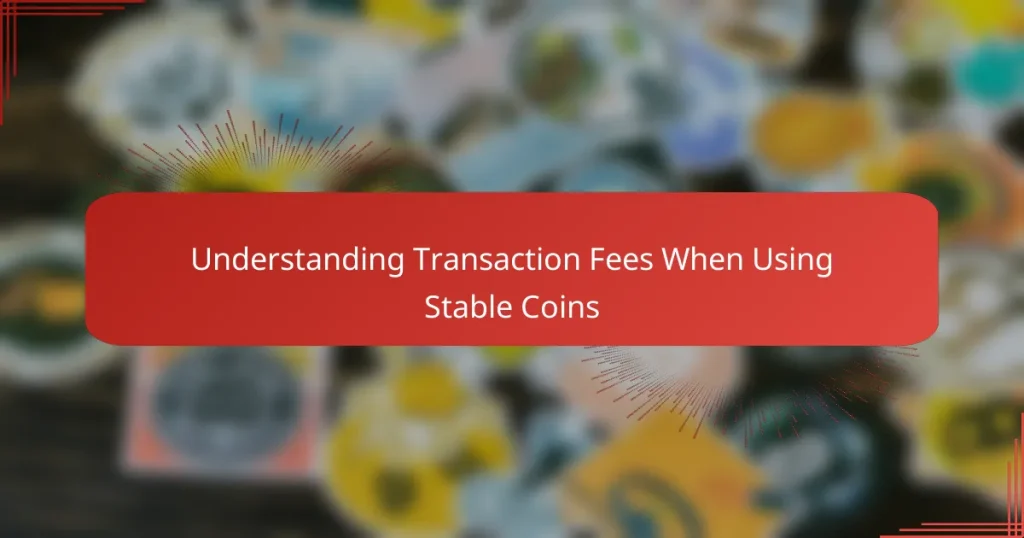Transaction fees for stable coins are the costs associated with transferring these digital currencies, influenced by various factors such as the blockchain network, transaction size, and network congestion. Understanding these fees is essential for users to effectively manage their costs and make informed decisions when conducting transactions. By considering elements like the coin’s popularity and the exchange platform used, individuals can navigate the complexities of stable coin transactions more efficiently.
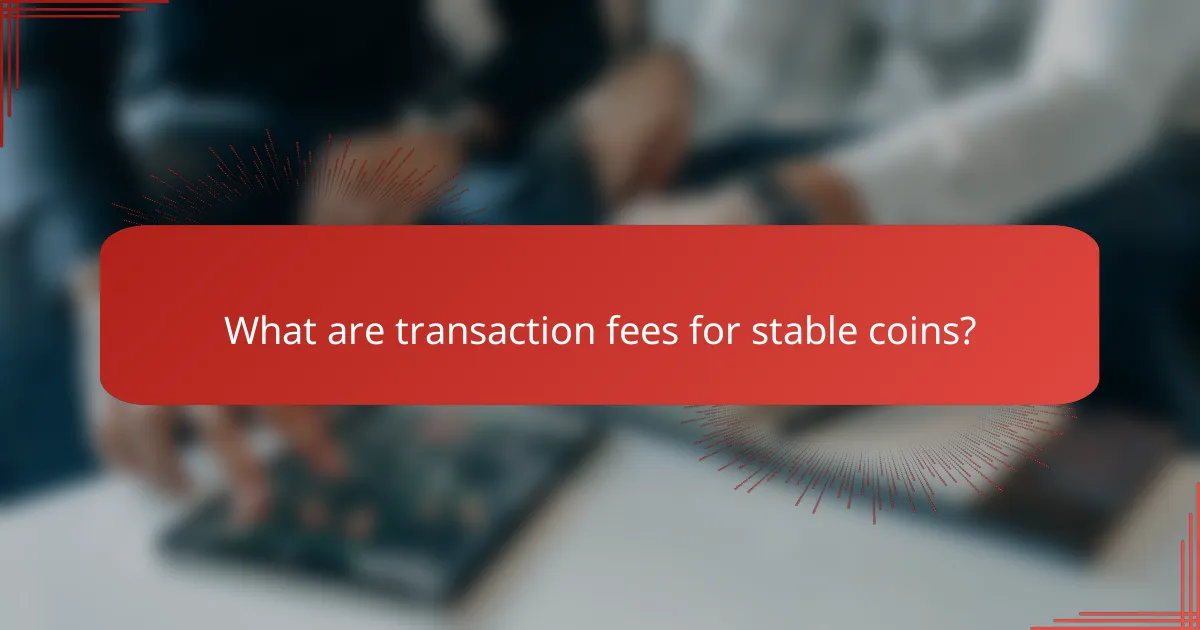
What are transaction fees for stable coins?
Transaction fees for stable coins are charges incurred when transferring these digital currencies. These fees can vary based on the blockchain network used, the transaction size, and network congestion.
Definition of transaction fees
Transaction fees are payments made to miners or validators for processing and confirming transactions on a blockchain. In the context of stable coins, these fees are typically paid in the native cryptocurrency of the blockchain, such as Ethereum’s ETH for ERC-20 tokens.
Fees can be fixed or variable, depending on the network’s demand and the complexity of the transaction. For example, during peak times, fees may increase significantly, while they can be lower during off-peak hours.
Importance of transaction fees
Transaction fees play a crucial role in maintaining the security and efficiency of blockchain networks. They incentivize miners or validators to prioritize transactions, ensuring timely processing.
Understanding these fees is essential for users, as they can impact the overall cost of using stable coins. For instance, if fees are high, it may be more economical to wait for lower congestion periods to execute transactions, thereby saving money.
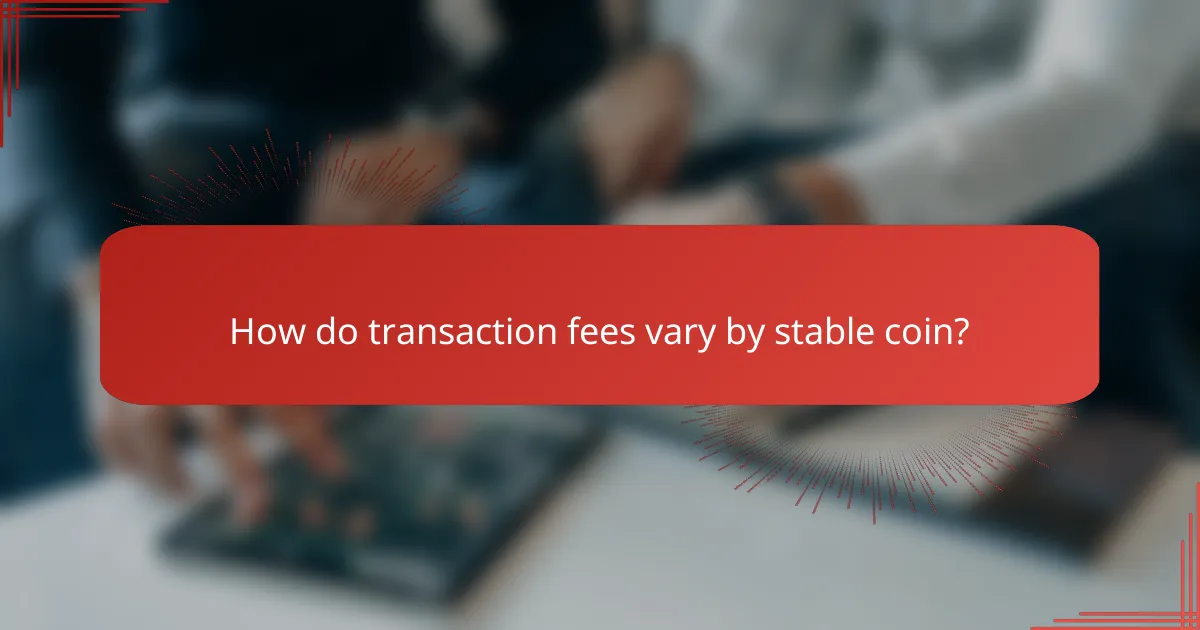
How do transaction fees vary by stable coin?
Transaction fees for stable coins can differ significantly based on the underlying blockchain technology and network congestion. Factors such as the coin’s popularity, the platform used for transactions, and the current demand for network resources all contribute to these variations.
Fees for Tether (USDT)
Tether (USDT) transaction fees can vary depending on the blockchain used. On the Ethereum network, fees can range from a few dollars to significantly higher amounts during peak times due to gas prices. On the Tron network, fees are generally much lower, often just a few cents.
When using USDT, it’s essential to consider the platform you are using for the transaction, as exchanges may impose additional fees on top of the network fees. Always check the current rates before proceeding with a transaction.
Fees for USD Coin (USDC)
USD Coin (USDC) typically incurs lower transaction fees, especially when transacted on the Ethereum network, where fees can fluctuate based on network activity. Users can expect fees in the low single-digit dollar range during normal conditions, but these can spike during high traffic periods.
Some platforms offer fee-free transactions for USDC, particularly when using their native wallets. It’s advisable to explore different platforms to find the most cost-effective option for your transactions.
Fees for DAI
DAI transaction fees are generally influenced by the Ethereum network, similar to USDC. Users can expect to pay anywhere from a few cents to several dollars, depending on network congestion. DAI can also be used on other blockchains, which may offer lower fees.
When using DAI, consider utilizing decentralized exchanges or platforms that support lower fees, especially during times of high demand. Monitoring network conditions can help you choose the best time to transact for minimal fees.

What factors influence transaction fees?
Transaction fees for stable coins can vary significantly based on several key factors, including network congestion, transaction size, and the fees charged by the exchange platform. Understanding these elements can help users manage costs effectively when making transactions.
Network congestion
Network congestion occurs when there are more transactions being processed than the network can handle, leading to increased fees. During peak times, such as market surges or major announcements, fees can spike, often reaching several times the normal rate.
To mitigate high fees during congested periods, consider timing your transactions for off-peak hours or using networks with lower congestion levels. Monitoring network status through various blockchain explorers can provide insights into current conditions.
Transaction size
The size of a transaction, measured in bytes, directly impacts the fees. Larger transactions typically incur higher fees because they require more resources to process. For example, a simple transfer of stable coins may cost less than a complex transaction involving multiple tokens or smart contracts.
To minimize costs, keep transactions concise and avoid unnecessary complexity. If possible, consolidate smaller transactions into one larger transfer to reduce the overall fee burden.
Exchange platform fees
Different exchange platforms charge varying fees for transactions involving stable coins. These fees can be a flat rate or a percentage of the transaction amount, and they may differ based on the payment method used, such as credit cards or bank transfers.
Before choosing an exchange, compare the fee structures of several platforms. Look for promotions or fee waivers that may apply to your transaction type, and always factor in these costs when calculating the total expense of your stable coin transactions.
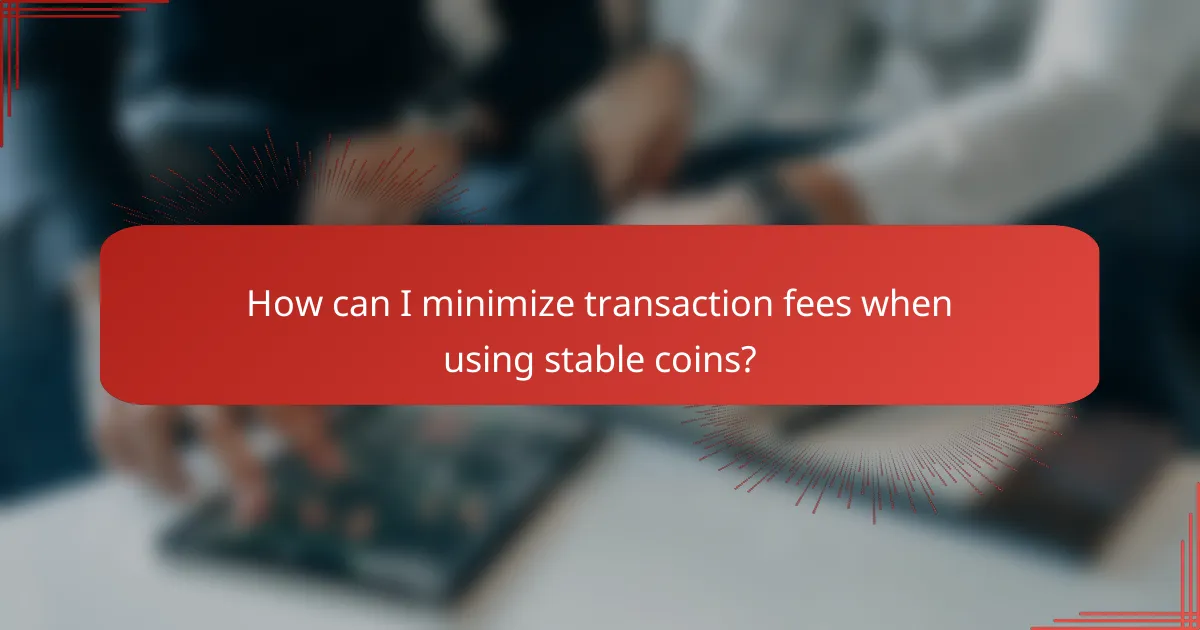
How can I minimize transaction fees when using stable coins?
To minimize transaction fees when using stable coins, consider selecting the right exchange and utilizing layer-2 solutions. These strategies can significantly reduce costs associated with trading and transferring stable coins.
Choosing the right exchange
Selecting an exchange with low fees is crucial for minimizing costs when using stable coins. Different platforms have varying fee structures, so compare trading fees, withdrawal fees, and deposit fees before making a choice.
Some exchanges may offer fee-free trading for specific stable coins or during promotional periods. Look for exchanges that support stable coin pairs with low spreads, as this can also help reduce overall transaction costs.
Using layer-2 solutions
Layer-2 solutions, such as the Lightning Network for Bitcoin or Optimistic Rollups for Ethereum, can significantly lower transaction fees. These technologies allow transactions to be processed off the main blockchain, reducing congestion and costs.
When using stable coins, consider platforms that integrate layer-2 solutions to take advantage of faster and cheaper transactions. However, ensure that the layer-2 solution is compatible with your chosen stable coin and that you understand any associated risks.
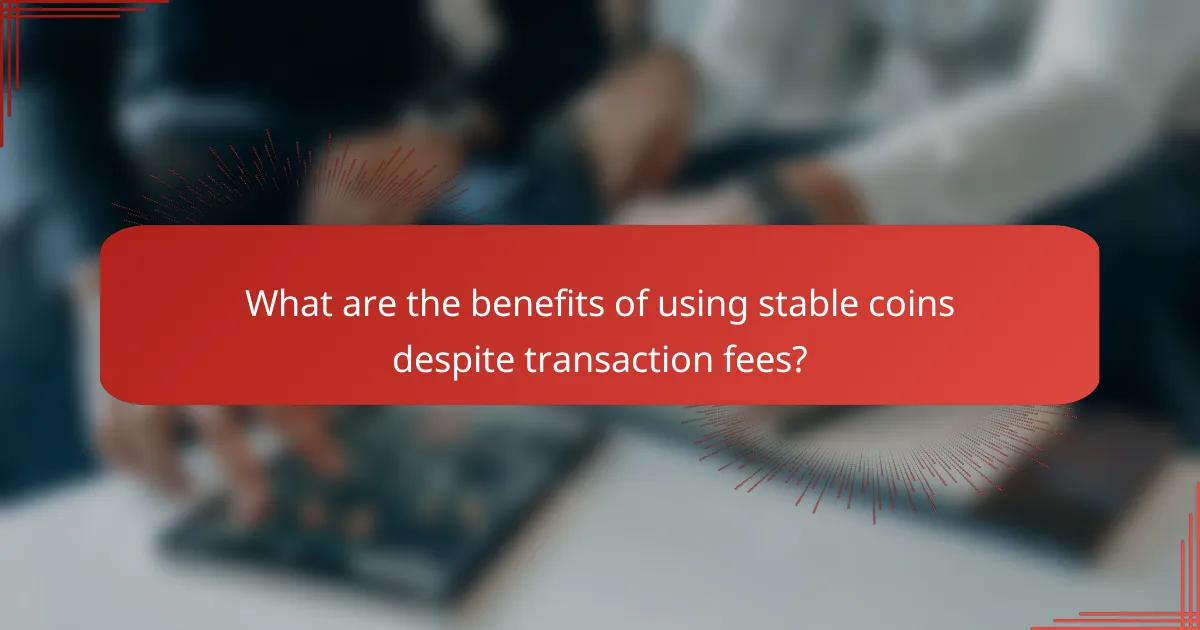
What are the benefits of using stable coins despite transaction fees?
Stable coins offer significant advantages, including price stability and accessibility in global markets, which can outweigh the transaction fees associated with their use. These benefits make stable coins an attractive option for individuals and businesses looking to navigate the cryptocurrency landscape.
Price stability
Stable coins are designed to maintain a stable value, often pegged to a fiat currency like the US dollar or the euro. This price stability reduces the volatility commonly associated with cryptocurrencies, making it easier for users to plan transactions and manage budgets.
For example, if a stable coin is pegged to the US dollar, one stable coin will generally be worth one dollar. This predictability allows users to avoid the drastic price swings that can occur with other cryptocurrencies, providing a more reliable medium for transactions.
Accessibility in global markets
Stable coins enhance accessibility in global markets by allowing users to transact across borders without the need for traditional banking systems. This can be particularly beneficial in regions with limited access to banking services or where currency exchange rates fluctuate significantly.
Using stable coins can facilitate quicker and cheaper international transactions. For instance, transferring funds using stable coins can often be completed in minutes, compared to several days for traditional bank transfers, and with lower fees than conventional remittance services.
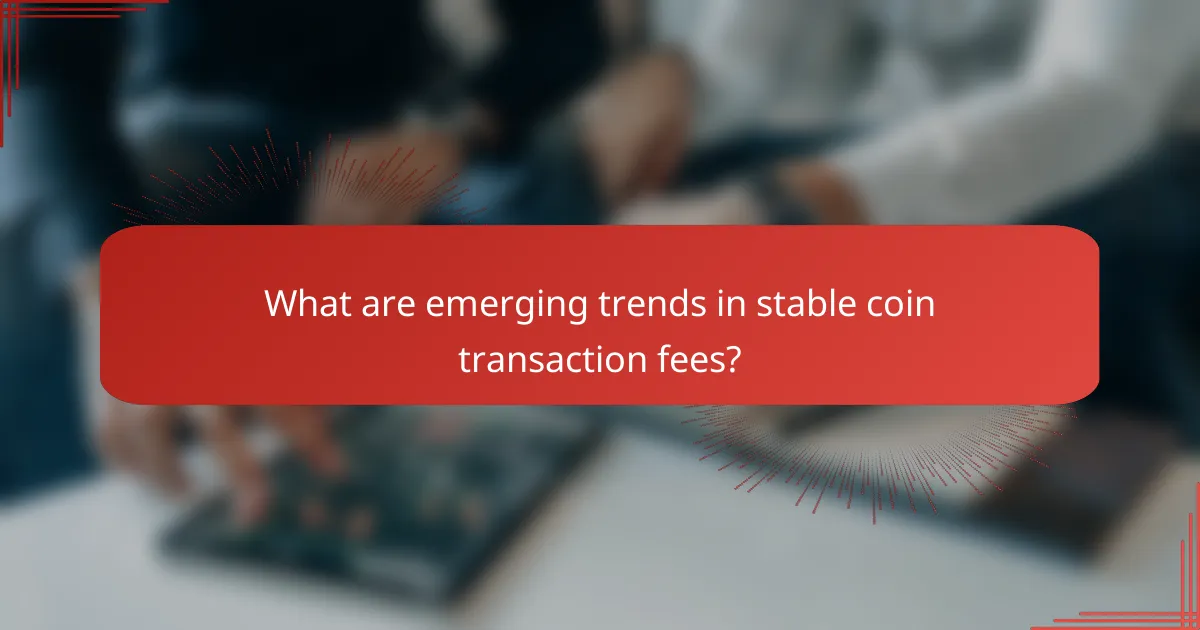
What are emerging trends in stable coin transaction fees?
Emerging trends in stable coin transaction fees indicate a shift towards lower costs and increased transparency. As the stable coin market matures, users are seeing a variety of fee structures, influenced by factors such as network congestion and the rise of decentralized finance (DeFi) platforms.
Decentralized finance (DeFi) impact
Decentralized finance (DeFi) has significantly influenced stable coin transaction fees by introducing new protocols and platforms that often offer lower fees compared to traditional financial systems. Users can benefit from reduced costs when trading or swapping stable coins on DeFi exchanges, which typically charge lower fees than centralized exchanges.
However, it is essential to consider the trade-offs, such as potential slippage during high volatility periods and varying fees based on network congestion. Users should regularly compare fees across different DeFi platforms to find the most cost-effective options.
Regulatory changes affecting fees
Regulatory changes are increasingly shaping the landscape of stable coin transaction fees. Governments worldwide are scrutinizing stable coins, which may lead to new compliance costs that could be passed on to users in the form of higher fees. For example, regulations requiring enhanced transparency and reporting could increase operational costs for issuers.
Staying informed about regulatory developments is crucial for users, as these changes can impact the overall cost of using stable coins. Monitoring updates from financial authorities can help users anticipate fee adjustments and make informed decisions about their transactions.
